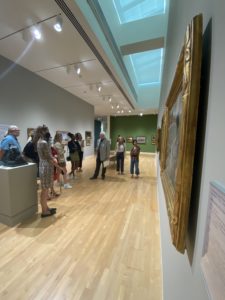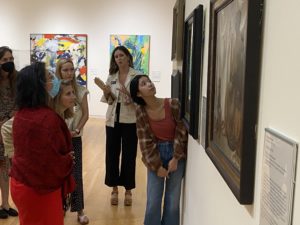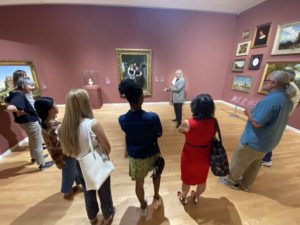Athens
Nov 9, 2022
When the Worlds of Art and Medicine Collide
La Confidence hangs on a wall at the Georgia Museum of Art.
What do you see?
Two friends whispering a secret? Or two lovers sharing a moment alone?
 These observations and details are what Augusta University/University of Georgia Medical Partnership students are trying to decipher when they take part in a program that combines the worlds of art and medicine.
These observations and details are what Augusta University/University of Georgia Medical Partnership students are trying to decipher when they take part in a program that combines the worlds of art and medicine.
Dr. Jonathan Murrow, the Medical Partnership’s campus associate dean for research, had the idea to start the program that would force medical students to look beyond the surface and notice more than meets the eye. He partnered with Dr. Bill Eiland at the Georgia Museum of Art (GMOA) to make the idea a reality.
“Dr. Eiland and I thought that amongst the many things medical students are asked to learn about health and disease there was an opportunity to challenge them to think differently about visual data,” said Murrow. “The visual arts provide an excellent context to do this, and Dr. Eiland was keen to curate this experience for them.”
Dr. Carrie Kelly, assistant professor of pediatrics, said she joined Murrow’s efforts due to her love or art.
“I have developed an appreciation for how each person sees pieces differently and how that skill can be utilized in medical education,” said Kelly.
The goal is to allow students to observe the art and see more than is at the surface—something they need to learn for their careers in the world of medicine.
“When you look at a piece of art, you can ask yourself several questions. What do you see? What did the artist intend it to mean? What does it mean to you?” said Kelly. “This skill translates when looking at slides, radiologic images, and it truly translates to skills used in every patient visit. Observation is a huge part of patient care. It also helps see things from different perspectives, which is how we build empathy and understand how to address our biases which ultimately betters patient care.”
First-year students have already taken their trip to the GMOA, and Kelly and Murrow will be taking the second-year students in the spring.
“This year we have done a visit to the museum over the summer where students and faculty participated in observation and interpretation of art pieces,” said Kelly. “We also took the Year 1 class to the museum for a session called “Pattern Recognition”. This session was to help them begin to recognize patterns in art linking that to patterns in histology slides and  more. Dr. Murrow and I will be taking the Year 2 class to the museum in the spring to work on some observation skills that can be utilized in patient encounters.”
more. Dr. Murrow and I will be taking the Year 2 class to the museum in the spring to work on some observation skills that can be utilized in patient encounters.”
Kelly and Murrow give their thanks and praise to the GMOA staff for assisting the Medical Partnership students hone their observation skills before officially entering their career.
“Dr. Eiland challenges the students to look beyond the obvious when encountering a work of visual art,” said Murrow. “This is a key skill that physicians must enjoy in their day-to-day practice.”
Kelly hopes that the students are getting a lot out of the visits to the GMOA
“The incorporation of the humanities in medical education has been shown to improve the ability to see things from perspectives other than your own, which is an important skill in medicine,” said Kelly. “Incorporating humanities into medical education is something I feel can bring joy and excitement to learning. I hope that these visits are fulfilling and help the students learn more about what it is to be a physician.”
